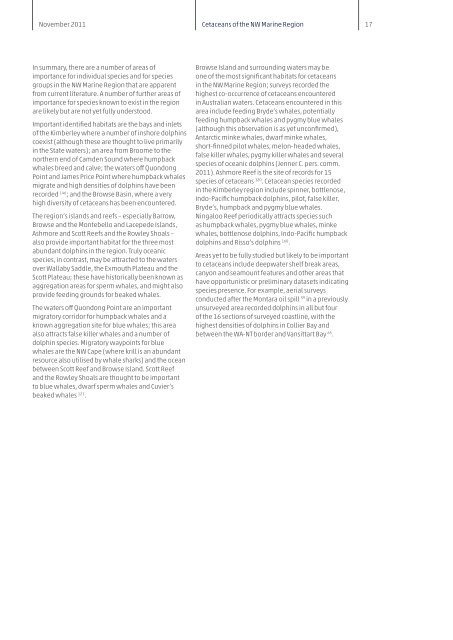Australia's last great whale haven.pdf - Ningaloo Atlas
Australia's last great whale haven.pdf - Ningaloo Atlas
Australia's last great whale haven.pdf - Ningaloo Atlas
- TAGS
- whale
- ningaloo
- atlas
- www.ifaw.org
You also want an ePaper? Increase the reach of your titles
YUMPU automatically turns print PDFs into web optimized ePapers that Google loves.
November 2011 Cetaceans of the NW Marine Region<br />
17<br />
In summary, there are a number of areas of<br />
importance for individual species and for species<br />
groups in the NW Marine Region that are apparent<br />
from current literature. A number of further areas of<br />
importance for species known to exist in the region<br />
are likely but are not yet fully understood.<br />
Important identified habitats are the bays and inlets<br />
of the Kimberley where a number of inshore dolphins<br />
coexist (although these are thought to live primarily<br />
in the State waters); an area from Broome to the<br />
northern end of Camden Sound where humpback<br />
<strong>whale</strong>s breed and calve; the waters off Quondong<br />
Point and James Price Point where humpback <strong>whale</strong>s<br />
migrate and high densities of dolphins have been<br />
recorded 146 ; and the Browse Basin, where a very<br />
high diversity of cetaceans has been encountered.<br />
The region’s islands and reefs – especially Barrow,<br />
Browse and the Montebello and Lacepede Islands,<br />
Ashmore and Scott Reefs and the Rowley Shoals –<br />
also provide important habitat for the three most<br />
abundant dolphins in the region. Truly oceanic<br />
species, in contrast, may be attracted to the waters<br />
over Wallaby Saddle, the Exmouth Plateau and the<br />
Scott Plateau; these have historically been known as<br />
aggregation areas for sperm <strong>whale</strong>s, and might also<br />
provide feeding grounds for beaked <strong>whale</strong>s.<br />
The waters off Quondong Point are an important<br />
migratory corridor for humpback <strong>whale</strong>s and a<br />
known aggregation site for blue <strong>whale</strong>s; this area<br />
also attracts false killer <strong>whale</strong>s and a number of<br />
dolphin species. Migratory waypoints for blue<br />
<strong>whale</strong>s are the NW Cape (where krill is an abundant<br />
resource also utilised by <strong>whale</strong> sharks) and the ocean<br />
between Scott Reef and Browse Island. Scott Reef<br />
and the Rowley Shoals are thought to be important<br />
to blue <strong>whale</strong>s, dwarf sperm <strong>whale</strong>s and Cuvier’s<br />
beaked <strong>whale</strong>s 121 .<br />
Browse Island and surrounding waters may be<br />
one of the most significant habitats for cetaceans<br />
in the NW Marine Region; surveys recorded the<br />
highest co-occurrence of cetaceans encountered<br />
in Australian waters. Cetaceans encountered in this<br />
area include feeding Bryde’s <strong>whale</strong>s, potentially<br />
feeding humpback <strong>whale</strong>s and pygmy blue <strong>whale</strong>s<br />
(although this observation is as yet unconfirmed),<br />
Antarctic minke <strong>whale</strong>s, dwarf minke <strong>whale</strong>s,<br />
short-finned pilot <strong>whale</strong>s, melon-headed <strong>whale</strong>s,<br />
false killer <strong>whale</strong>s, pygmy killer <strong>whale</strong>s and several<br />
species of oceanic dolphins (Jenner C. pers. comm.<br />
2011). Ashmore Reef is the site of records for 15<br />
species of cetaceans 120 . Cetacean species recorded<br />
in the Kimberley region include spinner, bottlenose,<br />
Indo-Pacific humpback dolphins, pilot, false killer,<br />
Bryde’s, humpback and pygmy blue <strong>whale</strong>s.<br />
<strong>Ningaloo</strong> Reef periodically attracts species such<br />
as humpback <strong>whale</strong>s, pygmy blue <strong>whale</strong>s, minke<br />
<strong>whale</strong>s, bottlenose dolphins, Indo-Pacific humpback<br />
dolphins and Risso’s dolphins 160 .<br />
Areas yet to be fully studied but likely to be important<br />
to cetaceans include deepwater shelf break areas,<br />
canyon and seamount features and other areas that<br />
have opportunistic or preliminary datasets indicating<br />
species presence. For example, aerial surveys<br />
conducted after the Montara oil spill 39 in a previously<br />
unsurveyed area recorded dolphins in all but four<br />
of the 16 sections of surveyed coastline, with the<br />
highest densities of dolphins in Collier Bay and<br />
between the WA-NT border and Vansittart Bay 65 .

















